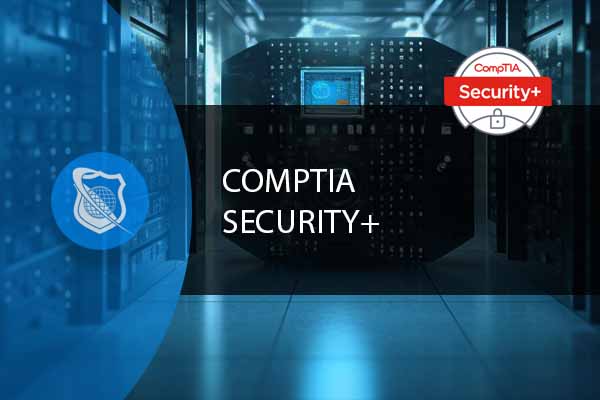If you’re an IT professional with years of experience under your belt or a student just embarking on your cybersecurity journey, the CompTIA Security+ certification is likely on your radar. This globally recognized certification serves as a cornerstone in the cybersecurity industry, validating the essential skills and knowledge required to secure a network and manage risk. But why is it so important? Because the cybersecurity landscape is a battlefield, and the warriors—be they seasoned professionals or newcomers—need to be well-armed. One of the key areas that the CompTIA Security+ exam focuses on is Threats Attacks and Vulnerabilities for CompTIA Security+
Understanding these concepts is not just beneficial; it’s absolutely essential for anyone serious about a career in cybersecurity. This blog on Threats Attacks and Vulnerabilities for CompTIA Security+, aims to delve deep into these critical areas, demystifying them and offering actionable insights. With two decades of experience in the field, we’ll explore the types of threats you’ll encounter, the attacks you’ll need to thwart, and the vulnerabilities you’ll have to secure. Whether you’re preparing for the CompTIA Security+ exam or simply looking to bolster your cybersecurity knowledge, this blog is your comprehensive guide.
Why Understanding Threats Attacks and Vulnerabilities for CompTIA Security+ is Crucial
In the dynamic and ever-evolving landscape of cybersecurity, the triad of threats, attacks, and vulnerabilities forms a critical nexus. This isn’t just jargon; these are the real-world challenges that cybersecurity professionals face every day. The importance of understanding these concepts cannot be overstated, not just for acing the CompTIA Security+ exam but also for excelling in the field of cybersecurity as a whole and is why I wrote this blog on Threats Attacks and Vulnerabilities for CompTIA Security+.
Secure Your Networks and Prevent Password Breaches
Our robust CompTIA Sec+ course is the perfect resouce to ensure your company’s most valuable assets are safe. Up your security skills with this comprehensive course at an exceptional price.
The Backbone of CompTIA Security+ Exam
Firstly, let’s talk about the CompTIA Security+ exam. This certification is designed to validate your foundational knowledge in cybersecurity, and a significant portion of the exam is dedicated to understanding Threats Attacks and Vulnerabilities for CompTIA Security+. If you’re aiming to pass this exam with flying colors, a deep understanding of these topics is not just recommended—it’s mandatory.
Real-world Implications – Threats Attacks and Vulnerabilities for CompTIA Security+
Beyond the exam, these concepts have real-world implications that can affect not just organizations but also individuals. Cyber threats are not limited to high-profile corporations or government entities; they can target anyone, anywhere. Understanding the different types of threats, how attacks are carried out, and where vulnerabilities lie can equip you with the skills needed to protect digital assets effectively.
A Dynamic Landscape
The world of cybersecurity is not static; it’s a dynamic landscape that changes rapidly. New threats emerge, attack methodologies evolve, and vulnerabilities are discovered regularly. Keeping up-to-date with these changes is essential for any cybersecurity professional. This is where a deep-rooted understanding of these core concepts comes into play. It allows you to adapt, evolve, and respond to new challenges effectively.
The Competitive Edge
In a field as competitive as cybersecurity, having a comprehensive understanding of Threats Attacks and Vulnerabilities for CompTIA Security+ can give you an edge over others. It’s not just about having theoretical knowledge; it’s about applying that knowledge in practical scenarios to identify risks and mitigate them proactively.
In conclusion, understanding Threats Attacks and Vulnerabilities for CompTIA Security+ is not just a section in an exam syllabus; it’s a crucial skill set that has far-reaching implications in the real world. Whether you’re an aspiring cybersecurity student or a seasoned professional, mastering these topics is key to your success in this ever-changing field.
Type of Threats
Threats Attacks and Vulnerabilities for CompTIA Security+
In the realm of cybersecurity, threats come in various shapes and sizes. While some are the result of human actions, others are caused by natural events or environmental factors. Understanding these different types of threats is the first step in creating a robust cybersecurity strategy. Let’s delve into each type in detail.
Natural Threats
The Unpredictability of Nature
Natural threats such as earthquakes, floods, and fires are often overlooked in cybersecurity planning, but their impact can be devastating. These events are not malicious in intent; Mother Nature doesn’t have a vendetta against your data center. However, the damage they can cause is very real.
The Impact on IT Infrastructure
When natural disasters strike, they can wreak havoc on an organization’s IT infrastructure. Servers can be destroyed, data can be lost, and network connections can be severed. The cost of downtime and data loss can run into millions, not to mention the loss of customer trust and potential legal repercussions.
Mitigation Strategies
While you can’t prevent natural disasters, you can prepare for them. This includes creating disaster recovery plans, backing up data in geographically diverse locations, and implementing failover systems to ensure business continuity.
Secure Your Networks and Prevent Password Breaches
Our robust CompTIA Sec+ course is the perfect resouce to ensure your company’s most valuable assets are safe. Up your security skills with this comprehensive course at an exceptional price.
Human Threats
The Complexity of Human Behavior
Human threats are often the most complex to defend against. These range from insider threats—employees with access to sensitive information—to external threats like social engineering and phishing attacks. The complexity lies in the unpredictability of human behavior and decision-making.
Types of Human Threats
Some common types of human threats include:
- Insider Threats: Employees who intentionally or unintentionally compromise security.
- Social Engineering: Manipulating individuals into divulging confidential information.
- Phishing: Sending fraudulent emails to trick recipients into revealing sensitive information.
Defense Mechanisms
Defending against human threats often involves a multi-faceted approach that includes employee training, robust access controls, and continuous monitoring of network activity.
Environmental Threats
The Overlooked Factors
Environmental threats are often the most overlooked but can have a significant impact on an organization’s cybersecurity posture. These include power failures, temperature fluctuations, and even pest control issues that can affect the performance and reliability of hardware.
Real-world Examples
For instance, a sudden power failure can lead to data loss or corruption. Temperature fluctuations in a data center can cause hardware to overheat, leading to potential failure. Even something as trivial as a pest infestation can lead to wiring damage.
Mitigation Measures
Preventive measures include uninterruptible power supplies (UPS), climate-controlled environments, and regular maintenance checks to ensure that all environmental factors are within safe operating parameters.
Types of Attacks
Threats Attacks and Vulnerabilities for CompTIA Security+
In cybersecurity, attacks can be broadly categorized into two types: passive and active. While both pose significant risks, they differ in their objectives, methodologies, and impact. Understanding these types of attacks is crucial for implementing effective security measures. Let’s explore each in more detail.
Passive Attacks
The Silent Observers
Passive attacks are often referred to as the “silent observers” in the cybersecurity world. These attacks don’t disrupt the normal functioning of a system but focus on gathering information. The attacker is like a spy, quietly collecting data without altering it.
Common Types of Passive Attacks
- Eavesdropping: This involves intercepting and listening to communication between two parties. While the data is not altered, it can be used for malicious purposes later.
- Traffic Analysis: Here, the attacker doesn’t necessarily look at the content of the communication but studies the patterns, frequency, and other metadata to gather intelligence.
The Risks Involved
While passive attacks may not disrupt system operations, they can lead to unauthorized access to sensitive information. This could include confidential business data, personal information, or even security credentials.
Countermeasures
Defending against passive attacks often involves strong encryption techniques, secure channels for communication, and regular monitoring to detect any unusual activity.
Active Attacks
The Disruptors
Unlike passive attacks, active attacks aim to alter or destroy data. These are the “disruptors” that can severely impact an organization’s operations and integrity.
Common Types of Active Attacks
- Denial of Service (DoS): This attack overwhelms a system, server, or network with traffic, rendering it inoperable and preventing legitimate users from accessing it.
- Man-in-the-Middle (MitM): In this attack, the attacker intercepts communication between two parties, altering the messages before they reach their destination.
The Consequences
The consequences of active attacks can be devastating. They can lead to data loss, financial losses, and a significant dent in an organization’s reputation. In extreme cases, they can even compromise the safety and well-being of individuals.
Countermeasures
Defending against active attacks requires a multi-layered approach that includes firewalls, intrusion detection systems, and robust authentication mechanisms. Regular system audits and updates are also crucial for identifying and patching vulnerabilities.
Secure Your Networks and Prevent Password Breaches
Our robust CompTIA Sec+ course is the perfect resouce to ensure your company’s most valuable assets are safe. Up your security skills with this comprehensive course at an exceptional price.
Types of Vulnerabilities
Threats Attacks and Vulnerabilities for CompTIA Security+
Vulnerabilities are the chinks in the armor of an organization’s cybersecurity strategy. They serve as potential entry points for attackers to exploit and gain unauthorized access to systems or data. These vulnerabilities can exist in software, hardware, or even in the human elements of an organization. Let’s delve into each type to understand them better.
Software Vulnerabilities
The Digital Doorways
Software vulnerabilities act like digital doorways that are left ajar, allowing attackers an easy entry point into your systems. These are often the result of coding errors, lack of updates, or configuration issues.
Common Types of Software Vulnerabilities
- Buffer Overflows: This occurs when a program writes more data to a buffer than it can handle, causing the excess data to overflow into adjacent memory spaces. This can lead to system crashes or unauthorized access to system memory.
- Unpatched Software: Software that hasn’t been updated with the latest security patches is a ripe target for attackers. These unpatched systems can have known vulnerabilities that are easy to exploit.
Mitigation Strategies
Regularly updating software and applying security patches are crucial steps in mitigating software vulnerabilities. Code reviews and vulnerability assessments can also help identify and fix potential issues before they can be exploited.
Hardware Vulnerabilities
The Physical Weak Points
Hardware vulnerabilities are often overlooked but can be just as damaging as their software counterparts. These can include firmware issues or even physical tampering with the hardware components.
Examples of Hardware Vulnerabilities
- Firmware Issues: Outdated or insecure firmware can be exploited to gain unauthorized access to hardware devices.
- Physical Tampering: Physical access to hardware can lead to vulnerabilities such as installing keyloggers or other malicious devices.
Countermeasures
Physical security measures like secure access to hardware components and regular hardware audits can help mitigate these risks. Updating firmware to the latest versions and conducting hardware vulnerability assessments are also effective strategies.
Human Factor
The Weakest Link
The human factor often proves to be the weakest link in the security chain. Despite the best software and hardware security measures, human error can still lead to significant vulnerabilities.
Common Human-Related Vulnerabilities
- Lack of Training: Employees who are not trained in cybersecurity best practices may inadvertently expose the organization to risks.
- Phishing Scams: Falling for phishing emails or scams is a common human-related vulnerability that can lead to unauthorized access to sensitive information.
Solutions
Regular training and awareness programs can go a long way in reducing human-related vulnerabilities. Simulated phishing exercises can also help employees recognize and avoid phishing attempts.
Conclusion
As we’ve explored in this comprehensive guide, understanding the intricacies of Threats Attacks and Vulnerabilities for CompTIA Security+ is not just a requirement for passing the CompTIA Security+ exam—it’s a fundamental necessity for anyone aspiring to excel in the cybersecurity field. These concepts serve as the building blocks of cybersecurity, and a deep understanding of them equips you with the tools to protect organizations and individuals from a wide array of cyber threats.
The Road to Certification and Beyond
Passing the CompTIA Security+ exam is a significant milestone, but it’s just the beginning of your journey in cybersecurity. The certification serves as a testament to your foundational knowledge, but the real-world challenges are ever-evolving. Continuous learning and adaptation are key to staying ahead in this dynamic field.
Practical Steps for Exam Preparation
- Start Your Preparation Today: Procrastination is the enemy of success. The sooner you start your preparation, the more time you’ll have to delve deep into each topic, understand the nuances, and solidify your knowledge.
- Take Practice Tests: Practice tests are invaluable in gauging your preparedness. They not only highlight your strong and weak areas but also give you a feel of the actual exam environment.
- Manage Your Time Wisely: Time management is crucial, both in your preparation and during the exam. Create a study schedule and stick to it. During the exam, be mindful of the time allocated for each section to ensure you answer all questions.
Secure Your Networks and Prevent Password Breaches
Our robust CompTIA Sec+ course is the perfect resouce to ensure your company’s most valuable assets are safe. Up your security skills with this comprehensive course at an exceptional price.
Your Next Steps
Don’t just read this blog and move on. Take action. Start your preparation, invest in quality study materials, and engage in practical exercises. Consider joining online forums or community groups focused on CompTIA Security+ to share knowledge and tips. Remember, the best time to start was yesterday; the next best time is now to learn the Threats Attacks and Vulnerabilities for CompTIA Security+
By taking these steps and applying the insights gained from this guide, you’re not just preparing to ace an exam—you’re laying the foundation for a successful career in cybersecurity.
CompTIA Security+ Guide: Understanding Threats, Attacks, and Vulnerabilities
What are the common types of CompTIA Security+ Threats, Attacks, and Vulnerabilities?
In the context of CompTIA Security+, threats can be defined as potential causes of incidents that may result in harm to a system or organization. Attacks are actions that exploit vulnerabilities to compromise confidentiality, integrity, or availability. Vulnerabilities refer to weaknesses that can be exploited by threats to cause harm. Common types include malware (e.g., viruses, worms, Trojan horses), phishing, social engineering, DDoS attacks, and exploiting software vulnerabilities.
How does understanding CompTIA Security+ Threats, Attacks, and Vulnerabilities help in cybersecurity?
Understanding these elements is crucial for cybersecurity professionals. It enables them to identify and assess risks, develop effective security policies and controls, and respond to and recover from incidents. By comprehensively understanding threats, attacks, and vulnerabilities, professionals can better protect the assets of their organization and mitigate potential security breaches.
What strategies are recommended for managing CompTIA Security+ Threats, Attacks, and Vulnerabilities?
Managing these security risks involves several strategies, including:
Risk Assessment: Identifying and evaluating risks to the organization’s assets.
Implementation of Security Controls: Applying administrative, physical, and technical controls to mitigate identified risks.
Regular Updates and Patch Management: Keeping systems and software up to date to protect against known vulnerabilities.
Employee Training and Awareness: Educating staff about common threats and security best practices.
Incident Response Planning: Preparing for, responding to, and recovering from security incidents.
How does CompTIA Security+ certification prepare professionals to deal with Threats, Attacks, and Vulnerabilities?
Identify and address security threats, attacks, and vulnerabilities effectively. The certification curriculum covers a wide range of security topics, including the latest trends and techniques in risk management, risk mitigation, threat management, and intrusion detection. By achieving this certification, professionals demonstrate their commitment to security and their ability to protect organizations from cyber threats.
Can you give an example of a recent CompTIA Security+ Threat, Attack, or Vulnerability?
While specific examples can change as new threats emerge, a notable trend is the rise of ransomware attacks, where attackers encrypt an organization’s data and demand payment for the decryption key. These attacks exploit vulnerabilities in network security, often entering through phishing emails or unpatched software. CompTIA Security+ professionals learn how to recognize the signs of such attacks, implement preventive measures, and respond effectively to minimize damage.
You may also like
CompTIA Security Plus Study Guide: 5 Mistakes to Avoid
CompTIA Sec+ Objectives: A Deeper Dive
The Importance of a Sec+ Cert When Starting Out In IT Security
CompTIA Security Plus Practice Test: Review, Study Plan, and the best 146 Practices Questions











